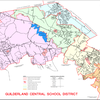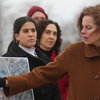Super says GCSD prepares students for rapidly changing world
Super says
GCSD prepares students for rapidly changing world
GUILDERLAND As enrollment declines in this suburban district, the superintendent said in his annual address, "The state of the Guilderland Central School District is strong...We’re having a good year."
As he frequently does, Gregory Aidala opened his speech with a reference to the districts mission empowering all students to succeed in the 21st Century.
He then outlined "two fundamental concepts": better educating children by providing "the highest level of services" and responding to a rapidly changing world "to teach new skills for a global economy."
Making his final state-of-the district address, since he announced he will retire next fall, Aidala said that education "is the heart of the American dream."
The address was given later than usual, mid-way through the school year. And, Aidala gave his speech to the school board in abbreviated form last Tuesday, in keeping with the boards new streamlined format; the full address is being broadcast on public-access Channel 16.
Guilderland enrollment declined this year slightly more than predicted, Aidala said. The district has 5,425 students, down 126 from last year. Over the next five years, enrollment will continue to drop to 5,006 students in 2011-12, Aidala said.
This does not include projections for Glass Works Village, a New Urbanist development proposed for Guilderland, which projects it will add 116 public-school students in six years, Aidala told The Enterprise.
Highlighting this school year, Aidala said that the district continued with federally-required testing in third through eighth grades, supported new principals Mary Summermatter at the middle school and Michael Piccirillo at the high school, and enhanced the district website www.guilderlandschools.org which averages almost 12,500 unique visitors each month.
He also mentioned initiatives including centralized registration for new students, ensuring that they are district residents; introducing surveillance equipment along with part-time monitors at the elementary schools; the school boards initiative in calling for a statewide task force to look at ways of addressing future employee retirement costs; completing the $20 million middle-school construction and expansion project; reviewing agreements for banking and legal services to save money; and introducing an energy management program that saved substantially.
Exit poll
In May, the $79 million budget passed by 56 percent with 1,898 yes votes. For the first time in recent years, the district conducted an exit poll, which 1,219 voters filled out.
Forty-three percent of those who responded had children attending Guilderland schools, according to results obtained by The Enterprise through a Freedom of Information Law request. Another 44 percent had children who had once attended the Guilderland schools.
Overall, 62 percent reported voting yes on the budget while 35 reported voting no.
Only 4 percent of the respondents were 30 or younger and 83 percent of them reported voting yes; 41 percent were between 31 and 50 and 71 percent voted yes; 33 percent were between 51 and 64 years old and 62 percent voted yes; 19 percent were 65 or older and 43 percent voted yes.
Seventy-seven percent of those with children in the Guilderland schools reported voting yes, 56 percent of those whose children once attended Guilderland schools voted yes, and 51 percent of those whose children never attended Guilderland schools voted yes.
Yes votes were highest from those with elementary children (80 percent) followed by middle-school children (77 percent), and then by high school-aged children (75 percent).
The biggest reason for voting yes (83 percent) was "I support education," followed by being pleased with the quality of education at Guilderland (67 percent), then the budget meeting the needs of students (60 percent), the tax increase being reasonable (47 percent), and feeling well-informed on the budget (34 percent).
The biggest reason for voting no (71 percent) was because the spending and tax increase was not reasonable, followed by not being able to afford the cost despite supporting education (52 percent), followed by not being pleased with the quality of Guilderland education (23 percent), the budget not meeting student needs (15 percent) and, finally, not feeling well-informed on the budget (15 percent).
Most learned about the budget through the printed word 72 percent or 880 people through the district newsletter mailed to every home (of which 66 percent reported voting yes), 45 percent, or 548, through local newspapers (with 58 percent voting yes), and 28 percent or 338 through school newsletters (with 66 percent voting yes).
Additionally, 17 percent learned about the budget through friends or neighbors (with 66 percent voting yes), 14 percent through district staff members (with 90 percent voting yes), 13 percent through board of education meetings (with 77 percent voting yes), 9 percent through the district website (with 71 percent voting yes), and 8 percent through the PTA (with 88 percent voting yes).
Scores of additional comments were reported from the surveys as well. Reasons for voting yes ranged from "I work for the district" to "Greg Aidala is very charming."
Some exclaimed in capital-letter gratitude: "It’s the RIGHT thing to do! GREAT JOB! Thanks for all your HARD work! My kids have received the BEST education! Very cheaply, I might add!"
Reasons for no votes ranged from "They lie" to "Too much waste."
Some expressed frustration over "the arrogance of the school board and administrations" or in rising costs: "Wasn’t state aid increased" Enough already. I’d like a raise, too! I’m on a fixed income-Do you really give a ----!"
In his state-of-the district address, Aidala reported on comments stating, "I want my town to be strong and education is a factor," and "Budget increases are too much each year. School taxes are too high in the Guilderland district."
Progress update
Data analysis has been a high priority this school year, Aidala said. It is important for improving instruction, guiding curriculum, and focusing on student progress "so that no one falls through the cracks," said the superintendent.
Mary Helen Collen, newly hired as data coordinator, has compiled and shared data with staff to improve student performance, Aidala said.
Lisa Patierne, administrative dean, has worked on activities for incoming freshmen to smooth the transition to high school, said Aidala.
A task force on the school day is looking at how Guilderland can "maximize the use of instructional time for students and staff," he said. "There are no simple solutions."
An ad-hoc committee of English and social-studies faculty "has examined the balance of writing instruction" in search of a "more collaborative and equitable approach," he said. English teachers teach four courses, to allow more time for writing, while social studies teachers, like teachers in most other departments, teach five courses.
Aidala stressed the importance of professional development programs and he also said the school board has made efforts to have more dialogue with residents.
He outlined some issue for upcoming budget discussions, including starting the study of foreign language in elementary school, which the school board has set as a priority, and addressing rising health-insurance costs.
Aidala also noted a facilities committee will review elementary building needs, district-wide technology needs, and "building security enhancements," spurred by $1.72 million in state aid.
He concluded by talking about a visit administrators made to the University at Albanys nano-technology center in the fall followed by a visit from the high-school newspapers staff, covering it for The Journal.
The school board this year set one of its two priorities as technology education.
The skills that nano-tech professors said students need are consistent with Guilderlands objectives for its graduates, said Aidala. They must be critical thinkers and problem-solvers who can use technology as a tool and communicate effectively. They must also be proficient in core subject areas and able to interconnect many disciplines while being contributing team members.
"We know that the world is changing rapidly," said Aidala.
Guilderland will continue to set high expectations and help students who have difficulty, he said. The district will reinforce the link between classroom and home learning, promote respect and responsibility, encourage collaboration among faculty and staff, look for budget savings, maintain and build trust, and finally, "meet the inevitable daily challenges which face our district," said Aidala.


